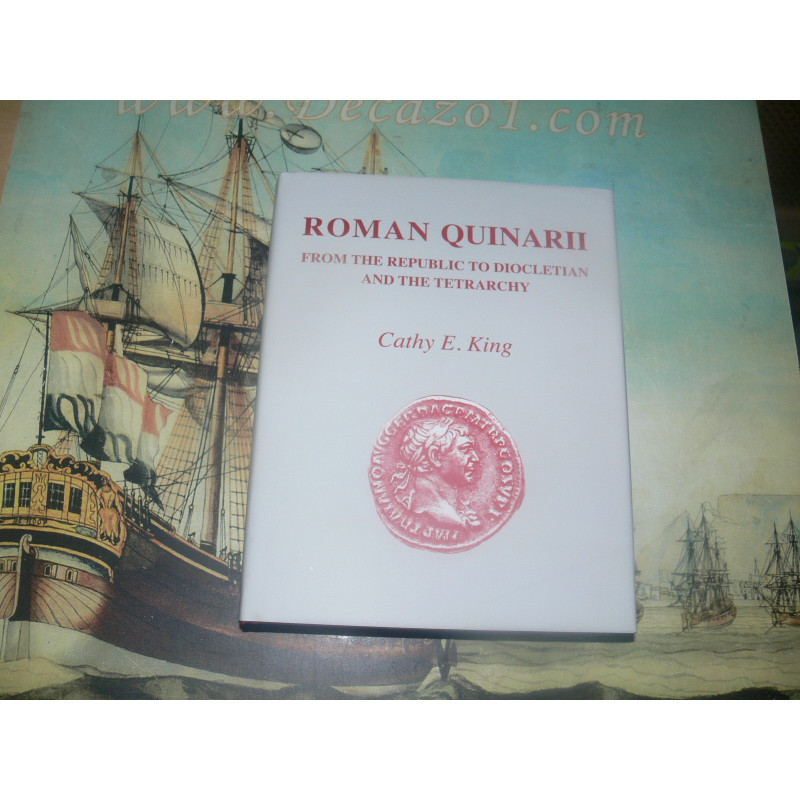


















King, Cathy E
Roman Quinarii: From the Republic to Diocletian and the Tetrarchy
First ed. 2007, hardcover, xxii, 436 pages, XXXVII plates (actual size), XVII plates (enlargements). Highly detailed work on the quinarius.
Long out of print.
New from old dealerstock!
For Condition, Index, and more details see photos.
 Security policy
Security policy
Decazo1 uses only functional & analytical cookies to navigate and improve the website.
 Delivery policy
Delivery policy
Items are shipped by PostNL or DPD with tracking or drop-off with signature.
 Return policy
Return policy
After delivery, 30 days (send email first) by registered mail. More Info in Shipping & Delivery
This impressive study focuses on just one denomination of coinage the quinarius, worth half a denarius, throughout the entire period of its issue. A major part of the work is taken up with a catalogue of all known examples. The remainder looks at the history and development of the coin, placing it within the context of the wider coinage system, and asking when and why the coin was minted, generally related to special dynastic occasions.
The silver quinarius is a half-denarius piece. It was introduced during the Roman Republic in the same coin reform that introduced the denarius c. 212 BC during the Second Punic War against Carthage under Hannibal. The denarius was worth 10 asses and the quinarius 5. Each was clearly marked with a Roman numeral, X for 10 or V for 5. To the right is an early quinarius with "V" behind the head of Roma in a winged helmet right. The reverse has the Dioscuri (Castor and Pollux) riding right (distinguished by stars above their heads) and ROMA below.
The design of early quinarii was virtually the same as the design of early denarii. However, quinarii were smaller, 15-17 mm instead of 19 mm, and half the weight, about 2 grams instead of 4 grams. Here is an early denarius for size comparison (to the same scale--all image sizes are proportional to coin sizes):
It is unusual for a book on coins to focus only on a single denomination. It is even more extraordinary to concentrate on a small coin like the quinarius (worth half a denarius) throughout the whole of its period of issue. But that is exactly what this volume does.
The catalogue is the core of the work. In it, quinarii are listed from the date when they were first minted during the Roman Republic to their final appearance in the late third century AD before Diocletian’s reform of the coinage. The author has included all specimens that could be verified that are listed in the major catalogues (e.g. RIC, BMC, etc.) as well as those from many public collections (both published and unpublished) and some that require reconfirmation that they actually exist.
Illustrations are lavish, 37 plates where the coins are illustrated at their actual size and 17 where selected items have been enlarged to 1½ times life-size. Where it has not been possible to illustrate a coin, every attempt has been made to supply references to photographs elsewhere.
The text has been divided into three chronological sections: the Republic to Domitian; the second century ending with Commodus; and the third century from AD 192 to Diocletian’s reform. Within each, the focus is on explaining when and where quinarii were minted, the way in which they operated within the coinage, and how their function evolved over time.
Detailed analysis of the sequence of issues, mint attribution, dating, and circulation also form a critical part of the discussion supported by tables, graphs, and drawings. Two bibliographies are also included; one general and one of find spots.
For those who wish to learn more about this minor but interesting denomination, this book is essential reading.
Weight: 1.850 kg. (packaging included)
Combined shipping
After registration (Important) the system automatically calculates the thickness and weight of every letter and gives you the rate for your Country. (If the combined order becomes to thick or heavy for a registered letter by PostNL, you automaticly see the rate for a parcel in your shoppingcart.)
Shipping is based on a 2 kg registered letter/parcel by PostNL, up to 2 kg no extra shipping costs if the books fit in the same letter/parcel.
Europe only: If its cheaper, we ship with DPD parcels (A 10 kg parcel often costs a few Euros more as a 2 kg parcel by PostNL, the standard shipping company) you will get a refund if you paid to much postage!
Shipping Refunds will be given by Bank or PayPal (The system cann't do this automatcally). Look for details under Shipping & Delivery in the Top Bar.
Combined shipping rules:
You have to combine all your purchases in one order, otherwise the system will see the purchases as seperate orders and start again with the basic rate for a 2 kg registered letter/parcel.
If you accidentally place more orders, we will recalculate the postage and give you a refund. We always ship for the lowest possible costs!
We ship Worldwide, if you cann't register or place your order, please contact us by e-mail: decazo1@hotmail.com